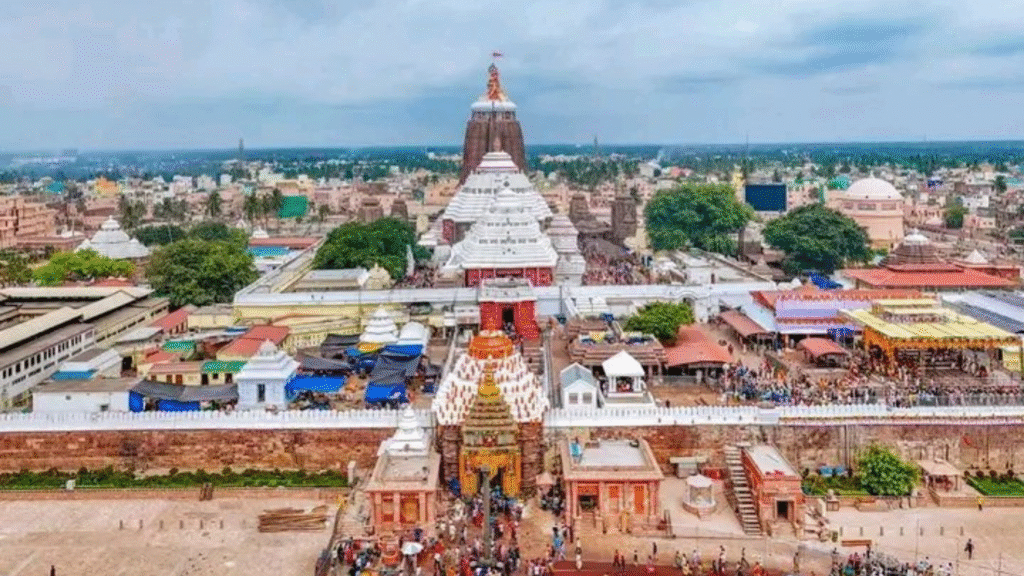Deva Snana Purnima, also called Snana Yatra, is a vibrant festival celebrated in Puri, Odisha, where devotees gather to honor Lord Jagannath, Balabhadra, and Subhadra. Held on the full moon day of the Hindu month of Jyeshtha, this event marks the ceremonial bathing of these deities, believed to be Lord Jagannath’s birthday. The festival, steeped in devotion, draws thousands to the Jagannath Temple to witness the grand rituals. It’s a time of spiritual cleansing, where devotees believe seeing the deities during this ceremony washes away sins. The event sets the stage for the famous Rath Yatra, filling Puri with chants of “Jai Jagannath” and a sense of divine connection. This article explores the festival’s significance, rituals, and cultural impact, sharing its beauty in a simple, heartfelt way.
The Meaning of Deva Snana Purnima
Deva Snana Purnima is a sacred day when Lord Jagannath, his brother Balabhadra, and sister Subhadra are bathed in a grand ceremony at the Jagannath Temple in Puri. Celebrated on the full moon of Jyeshtha, it’s seen as the birthday of Lord Jagannath, a form of Lord Krishna. According to the Skanda Purana, King Indradyumna started this tradition when the deities were first placed in the temple. Devotees believe that witnessing the bathing ritual cleanses them of past and present sins, offering spiritual renewal. The festival is a prelude to the Rath Yatra, marking the start of a holy period in Odisha. It’s a time when Puri buzzes with devotion, as people from across India and beyond come to feel closer to the divine.
Why It’s Important
The festival holds deep meaning for devotees, especially Vaishnavas, who see Lord Jagannath as the Lord of the Universe. The bathing ritual, called Sahasradhara, symbolizes purification and rejuvenation. Many believe that seeing the deities on this day brings blessings and frees them from sins. It’s a moment of unity, where people from different backgrounds gather in Puri, sharing their faith. The event also strengthens the cultural identity of Odisha, as it’s tied to the ancient traditions of the Jagannath Temple.
Its Place in Jagannath Culture
In Jagannath culture, Deva Snana Purnima is a cornerstone, kicking off the Rath Yatra season. It’s more than a ritual—it’s a celebration of devotion, community, and Odisha’s heritage. The festival reflects the belief that Lord Jagannath is accessible to all, uniting people in a shared spiritual experience. From the temple’s priests to the thousands of visitors, everyone feels part of something sacred. The event’s traditions, like the Pahandi procession, showcase Odisha’s rich artistry and devotion, making it a cultural treasure.
The Rituals of Deva Snana Purnima
The rituals of Deva Snana Purnima are a spectacle of faith and tradition. Early in the morning, the deities—Lord Jagannath, Balabhadra, Subhadra, Sudarshana, and Madanmohana—are taken from the temple’s sanctum to the Snana Mandap, a bathing platform. Priests use 108 pitchers of herbal, fragrant water from the temple’s Suna Kua (Golden Well) to bathe them. After the bath, the deities are dressed in Sada Besha and later in Hathi Besha, resembling Lord Ganesha. The day ends with the Sahanamela, where devotees can see the deities up close. These rituals, filled with chants and music, create a divine atmosphere.
The Pahandi Procession
The day begins with the Pahandi, a grand procession where the deities are carried to the Snana Mandap. Starting at dawn, priests and servitors escort the idols with chants, drums, and cymbals. The Snana Mandap, set at a height, allows devotees outside the temple to catch a glimpse. The procession, vibrant with flowers and traditional decorations, fills Puri with energy. Thousands gather, eager for a look, as the air echoes with “Jai Jagannath.” This ritual sets a joyful tone for the day.
The Bathing Ceremony
The bathing, or Sahasradhara, is the heart of the festival. Priests fetch water from the Suna Kua, purifying it with herbs, sandalwood, and flowers. Using 108 copper pitchers, they pour the water over the deities while chanting mantras. This act symbolizes spiritual cleansing, believed to purify both the deities and the devotees watching. The ritual, performed with devotion, draws lakhs of people who see it as a chance to connect with Lord Jagannath and seek his blessings.
The Anasara Period
After the bath, the deities are believed to “fall ill” from the extensive bathing, entering a 15-day seclusion called Anasara. They’re moved to the Anasar Gruha, a special chamber, where the Raj Vaidya (royal physician) tends to them with Ayurvedic remedies. During this time, devotees can’t see the deities, and three patachitra paintings are displayed instead. This period ends with the Netrotsava, when the deities, repainted and rejuvenated, reappear, symbolizing eternal youth. The Anasara adds a layer of mystique to the festival.
The Spiritual Significance
Deva Snana Purnima is more than a ritual—it’s a spiritual journey. Devotees believe that seeing Lord Jagannath during the bathing ceremony washes away sins and brings divine blessings. The festival embodies the idea that Jagannath is the Lord of the Universe, accessible to all, regardless of background. It’s a time for devotees to renew their faith, seek forgiveness, and feel closer to the divine. The belief that the deities “rest” after the bath, like humans, makes them relatable, deepening the emotional bond devotees feel. This spiritual connection draws millions to Puri each year.
Cleansing of Sins
A core belief is that witnessing the Snana Yatra cleanses devotees of sins from past and present lives. The Skanda Purana says King Indradyumna began this ritual to honor Jagannath’s appearance, making it a powerful moment for spiritual renewal. Devotees flock to Puri, believing that even a glimpse of the deities during the bath brings salvation. This promise of purification makes the festival a magnet for pilgrims seeking to start anew.
Connection to Lord Jagannath
Lord Jagannath is seen as a loving, universal deity who unites people. During Deva Snana Purnima, this connection feels personal. Devotees, from locals to foreigners, describe the festival as a moment when Jagannath’s divine love touches everyone. The open setting of the Snana Mandap lets all, regardless of status, share in the experience. This accessibility strengthens the bond between Jagannath and his devotees, making the festival a celebration of divine unity.
Cultural and Social Impact
Deva Snana Purnima is a cultural jewel for Odisha, showcasing its traditions, art, and community spirit. The festival brings Puri to life, with streets filled with music, flowers, and devotion. It strengthens Odisha’s identity, as locals take pride in their role as hosts to millions. The event also boosts the local economy, with vendors, artisans, and hotels thriving. Beyond Odisha, it attracts global devotees, including those from ISKCON and countries like Bangladesh, spreading Jagannath culture worldwide. The festival fosters unity, as people of all backgrounds join in worship.
Community and Unity
The festival creates a sense of togetherness, as lakhs of devotees gather in Puri. From the Pahandi to the Sahanamela, people share moments of joy and faith. Visitors from Bangladesh, ISKCON devotees, and even foreigners, like a Russian devotee who called Jagannath the unifier of all, feel part of one spiritual family. The open rituals, visible to all, break barriers of caste or creed, embodying the idea of Vasudhaiva Kutumbakam—one global family.
Boost to Local Economy
Deva Snana Purnima transforms Puri into a bustling hub. Local vendors sell flowers, food, and souvenirs, while hotels and guesthouses fill up. Artisans benefit from the demand for patachitra paintings and decorations. The festival’s scale, with thousands attending, pumps money into the community. Temporary jobs, like security or guiding, also emerge, as seen with the deployment of 70 platoon forces for crowd management in 2025. This economic boost supports Puri’s residents while showcasing Odisha’s hospitality.
How to Experience Deva Snana Purnima
Experiencing Deva Snana Purnima means immersing yourself in Puri’s spiritual energy. Arrive early to catch the Pahandi at dawn, and find a spot near the Snana Mandap for a clear view. Follow temple rules, like entering through the Lion Gate and exiting via other gates. Dress modestly and respect the crowds. You can also visit nearby temples or explore Puri’s beaches to soak in the festive vibe. Joining the chants and offering prayers deepens the experience. For 2025, the festival falls on June 11, with the Purnima tithi starting at 11:36 AM on June 10.
Planning Your Visit
To enjoy Deva Snana Purnima, plan ahead. Book accommodations in Puri early, as hotels fill up fast. Arrive a day before to settle in. On June 11, 2025, reach the temple by 5 AM for the Pahandi. Enter through the Lion Gate and follow barricades for orderly viewing. Tickets for closer access are available via the south gate. Bring water and wear comfortable clothes, as crowds can be intense. Check temple websites for updates on timings and restrictions.
Respecting Traditions
Respecting the festival’s traditions is key. Dress in traditional or modest clothing, avoiding shorts or revealing outfits. Follow temple guidelines, like using designated gates and avoiding photography where prohibited. Join in the chants respectfully, and be patient in the crowds. Offerings like flowers or donations should be given through priests. Understanding the rituals, like the Anasara period, adds meaning to your visit. By honoring these customs, you connect deeply with the festival’s spirit and the devotion of fellow pilgrims.



